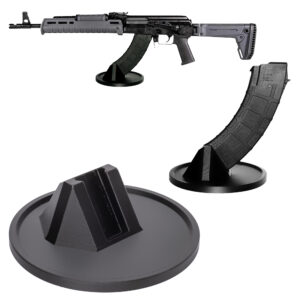Categories:
The origins and development of the AK-47, one of the most iconic rifles in history, can be traced back to the tumultuous period following World War II. The Soviet Union, keen on modernizing its military arsenal and ensuring superiority over potential adversaries, embarked on a quest to develop a reliable, simple, and effective gun that could be mass-produced with ease. This mission led to the creation of the Avtomat Kalashnikova model 1947—better known as the AK-47.
The rifle’s inception is closely associated with Mikhail Kalashnikov, a Soviet tank commander turned arms designer. Wounded during World War II, Kalashnikov began conceptualizing a new type of automatic rifle while recuperating from his injuries. He sought to combine the advantages of various guns he had encountered: the reliability and ease of use found in submachine guns like the German MP40 and Soviet PPSh-41, along with the stopping power characteristic of rifles like the American M1 Garand.
After several iterations and extensive testing by Soviet military engineers throughout 1946 and early 1947, Kalashnikov’s design was selected for further refinement. The final product was officially adopted by the Red Army in 1949 as their standard issue infantry weapon. Its distinctive features included a gas-operated mechanism with a rotating bolt system that ensured remarkable reliability under harsh conditions—be it mud, sand, or extreme temperatures.
One key aspect contributing to its widespread adoption was its simplicity in both construction and operation. The AK-47 was designed with fewer moving parts than many contemporary guns, which made it easier for soldiers—often conscripts without extensive training—to maintain and operate effectively. Additionally, its stamped sheet metal components allowed for rapid mass production—a crucial advantage during times of conflict.
As geopolitical tensions escalated during the Cold War era, so too did the proliferation of this revolutionary gun. It became synonymous not only with Soviet military might but also with various liberation movements worldwide who saw it as an emblematic tool against oppression.
Thus emerged an enduring legacy: a weapon born out of necessity that quickly transcended national borders to become an indelible part of global military history.
The AK-47, officially known as the Avtomat Kalashnikova, has achieved legendary status partly due to its groundbreaking design features and innovations. One of the most significant aspects of its design is its simplicity. Mikhail Kalashnikov, the principal designer, created a rifle that could be easily operated and maintained by soldiers with minimal training. This simplicity extends to its assembly and disassembly process, which can be performed quickly under various conditions without requiring specialized tools.
Another key innovation lies in the AK-47’s remarkable reliability. The rifle was engineered to function effectively in a wide range of harsh environments—whether it be arid deserts, humid jungles, or frozen tundras. This reliability is largely attributed to the rifle’s loose tolerances between moving parts, which allow it to continue operating even when exposed to dirt, mud, or other debris that would typically jam more finely-tuned guns.
Furthermore, the AK-47 utilizes a gas-operated mechanism with a long-stroke piston system. This design reduces recoil and enhances control during rapid fire. Unlike many other rifles of its time which relied on more complex mechanisms prone to failure under stress or adverse conditions, this gas-operated system contributed significantly to the weapon’s durability and ease of use.
The choice of materials also played a crucial role in defining the AK-47’s functionality. Initially made from stamped sheet metal before transitioning to milled steel receivers due to manufacturing difficulties during early production runs—this combination offered both affordability and robustness. The wooden stock and foregrip provided durability while minimizing weight.
Additionally, its 7.62x39mm cartridge strikes an effective balance between power and manageability. It offers sufficient stopping power for battlefield effectiveness without producing excessive recoil that could compromise accuracy during automatic fire.
In summary, the AK-47’s design features—a testament to pragmatic engineering—embody simplicity, reliability, ease of maintenance, durable material choice, effective ammunition pairing—all contributing factors that have cemented its place as one of history’s most iconic rifles.
The AK-47’s reputation for durability and reliability in combat is one of the key factors that have cemented its status as an iconic rifle. Designed by Mikhail Kalashnikov in the aftermath of World War II, this assault rifle was engineered to function under the most extreme conditions, making it a preferred choice for military forces around the globe.
One of the primary reasons for its exceptional reliability is its simple and robust construction. The AK-47 has fewer moving parts compared to many other rifles, which minimizes the risk of mechanical failure. Its loose tolerances are particularly noteworthy; while this might slightly reduce accuracy, it significantly enhances the rifle’s ability to function when fouled with dirt, mud, or sand—an invaluable trait in harsh environments like jungles, deserts, and urban battlefields.
The rifle’s gas-operated mechanism further contributes to its reliability. It uses a long-stroke piston system that channels gas from fired cartridges to cycle the action. This design not only reduces recoil but also ensures that debris is less likely to impede operation. The gas tube itself is somewhat oversized, allowing it to continue functioning even when dirty—a crucial advantage during prolonged engagements where maintenance opportunities are scarce.
Another testament to the AK-47’s durability is its ability to withstand extreme temperatures and weather conditions. Whether exposed to arctic cold or tropical heat and humidity, this weapon remains operational. Its wooden or laminated stock and stamped steel receiver are both resilient materials that can endure significant abuse without compromising performance.
Field tests have shown that even after being buried in sand or submerged in water, an AK-47 can still fire effectively with minimal cleaning required. This level of resilience has endeared it not only to regular armies but also guerrilla fighters who often operate with limited resources for weapon maintenance.
In summary, the AK-47’s unmatched durability and reliability stem from its simplistic yet effective design principles. These qualities have made it a ubiquitous presence in conflicts worldwide, ensuring its place as one of history’s most iconic rifles.
The global proliferation and usage of the AK-47 have cemented its status as one of the most iconic rifles in history. Originally designed by Mikhail Kalashnikov in 1947 for the Soviet armed forces, the AK-47 quickly became synonymous with both military strength and revolutionary fervor due to its widespread adoption. One of the primary reasons for its proliferation is its robust and straightforward design, which allows for easy manufacturing, even under less-than-ideal conditions.
This simplicity has facilitated mass production not only in Russia but also under license or through illicit means in numerous countries worldwide.
During the Cold War, the Soviet Union strategically distributed AK-47s to allied nations and revolutionary movements as part of their geopolitical strategy. This deliberate dissemination was aimed at supporting communist insurgencies and bolstering friendly regimes, thereby extending Soviet influence across Asia, Africa, Latin America, and the Middle East. As a result, countless paramilitary groups and national armies adopted this reliable gun.
The durability of the AK-47 further contributed to its global spread. Its ability to function effectively in harsh environments—ranging from jungles to deserts—made it a favorite among fighters who required reliability over precision. The rifle’s resilience ensured that once introduced into a region, it remained operational for decades with minimal maintenance.
Moreover, the weapon’s cultural impact cannot be overlooked. The silhouette of an AK-47 has become an emblematic image associated with resistance movements worldwide—from African liberation fronts to Middle Eastern militant groups. Its presence on flags and propaganda posters underscores its symbolic power beyond mere functionality.
In more recent decades, as conflicts have shifted from state-sponsored wars to asymmetric warfare involving non-state actors, the AK-47 has remained prevalent due to black market sales and continued production by various manufacturers around the globe. This enduring presence ensures that even today, over seventy years since its inception, the AK-47 continues to play a significant role in both conventional conflicts and guerrilla warfare alike.
Thus, through strategic distribution during pivotal historical moments coupled with unparalleled durability and symbolic significance, the AK-47 has achieved an unparalleled level of global proliferation and usage that few other guns can claim.
The cultural impact and symbolism of the AK-47 extend far beyond its mechanical reliability and battlefield effectiveness, embedding itself into the very fabric of global history and society. The rifle, designed by Mikhail Kalashnikov in 1947, has become an enduring icon that transcends its utilitarian origins to embody a plethora of meanings across different cultures.
One aspect of the AK-47’s cultural resonance is its representation of revolution and resistance. Used extensively in liberation movements throughout Africa, Asia, and Latin America during the Cold War era, the rifle became a symbol for anti-colonial struggles. Images of freedom fighters brandishing AK-47s were disseminated widely through media, romanticizing the weapon as an instrument of emancipation from oppressive regimes. Its silhouette is even featured on several national flags and emblems, such as Mozambique’s flag, signifying not just military strength but also a nation’s struggle for self-determination.
In popular culture, the AK-47 has cemented its place through films, music videos, literature, and video games. Hollywood blockbusters often depict it as the weapon of choice for rebels or insurgents, reinforcing its association with defiance against authority. In hip-hop culture particularly, references to “AK” are abundant in lyrics that speak to themes of power and survival in adverse conditions. This prevalence further embeds the gun into public consciousness as more than just a tool for combat but as a potent symbol within various social narratives.
However, this iconic status also carries darker connotations. The widespread availability of AK-47s has exacerbated conflicts by making lethal firepower accessible to child soldiers and criminal organizations alike. In these contexts—whether depicted in documentaries or news reports—the rifle represents chaos and violence rather than heroic resistance.
Thus, the cultural impact and symbolism of the AK-47 are multifaceted: it stands at once as an emblematic tool of rebellion against tyranny while also epitomizing modern-day conflict’s brutal realities. Its legacy is complexly interwoven with both hope for liberation and reminders of human suffering—making it one of history’s most iconic rifles not only due to its design but also because of what it has come to signify globally.
The AK-47’s iconic status cannot be fully appreciated without comparing it to other rifles that have shaped military history. Its direct contemporaries, such as the American M16, offer a contrasting backdrop that highlights the unique features and advantages of the AK-47.
One of the primary distinctions between the AK-47 and rifles like the M16 lies in their design philosophies. The M16, with its lighter 5.56mm cartridge, was designed for accuracy and range. It incorporates advanced materials like aluminum and fiberglass to reduce weight, aiming for precision over long distances. In contrast, the AK-47 uses a more powerful 7.62mm round, prioritizing reliability and stopping power at shorter ranges.
The heavier caliber contributes to its renowned lethality in close combat scenarios.
Durability is another significant factor where these rifles diverge. The AK-47 is famed for its robustness under harsh conditions—its loose tolerances allow it to function reliably even when exposed to mud, sand, or water. This resilience made it an ideal choice for guerrilla warfare in diverse environments ranging from jungles to deserts. Meanwhile, early models of the M16 initially faced criticism for jamming issues under similar conditions until subsequent improvements were made.
From an ease-of-use perspective, the AK-47’s simplicity stands out starkly against many Western-designed rifles. Its straightforward construction makes it easy to manufacture and maintain with minimal training—a crucial advantage for irregular forces or newly formed armies with limited resources. On the other hand, more sophisticated guns like the German G3 or Belgian FN FAL require higher levels of training and maintenance due to their more complex mechanisms.
In terms of cost-effectiveness and proliferation, no rifle rivals the AK-47’s global reach. Manufactured by numerous countries over decades without stringent intellectual property constraints that often accompany Western guns production, it became accessible on a massive scale.
While each rifle has its own set of strengths tailored to specific tactical philosophies and operational requirements, these comparisons underscore why the AK-47 remains one of history’s most enduring symbols of both military might and revolutionary struggle.
Despite its mid-20th-century origins, the AK-47 has maintained a significant presence in the modern era, a testament to its enduring appeal and functionality. The rifle’s continued relevance can be attributed to several key factors that have allowed it to transcend generations and geopolitical boundaries.
Firstly, the AK-47’s design remains remarkably effective even by today’s standards. Its simplicity and robustness make it suitable for various environments—from arid deserts to dense jungles—where more sophisticated weapons might falter. This durability is particularly valued in regions with limited access to advanced military logistics, where maintaining high-tech weaponry could be challenging.
Moreover, the proliferation of the AK-47 since its inception has made it one of the most accessible guns globally. During the Cold War, millions of these rifles were manufactured by Soviet-aligned nations and distributed widely among allied states and revolutionary movements. This widespread distribution created a vast network of users who became proficient with the weapon, ensuring that knowledge about its operation and maintenance was passed down through generations.
In contemporary conflicts, non-state actors often favor the AK-47 due to its reliability and ease of use. Guerrilla fighters, insurgents, and militias find it an ideal choice because it requires minimal training compared to more complex modern rifles. Its reputation for dependability under harsh conditions further cements its status as a weapon of choice among irregular forces.
Additionally, pop culture has played a significant role in solidifying the AK-47’s iconic status. From movies and video games to music videos and literature, this rifle is frequently depicted as both a symbol of rebellion and raw power. Such portrayals perpetuate its mythos, making it not just a tool of war but also an emblem ingrained in global consciousness.
In essence, while many modern rifles boast technological advancements that surpass those of the AK-47, few can claim its storied legacy or cultural impact. Its blend of durability, accessibility, ease of use—and an almost mythical reputation—ensures that this legendary gun continues to be relevant well into modern times.








Colt
Colt M4 Carbine
Colt LE6920
Colt AR-15 A4
Daniel Defense
DDM4 V7
DDM4 V9
DDM4 V11
DDM4 ISR (Integrally Suppressed Rifle)
Smith & Wesson (S&W)
M&P15 Sport II
M&P15 Tactical
M&P15T
Bravo Company Manufacturing (BCM)
BCM Recce-16
BCM Recce-14
BCM MCMR Series
Aero Precision
M4E1 Series
AC-15
AR15 Pistol (Various Configurations)
Ruger
Ruger AR-556
Ruger SR-556
Ruger AR-556 MPR (Multi-Purpose Rifle)
Springfield Armory
Saint Victor
Saint Edge
Saint AR-15
PSA (Palmetto State Armory)
PSA PA-15
PSA AR-V
PSA Jakl (AR Pistol)
FN America
FN 15 Tactical Carbine
FN 15 Patrol
FN 15 DMR
Wilson Combat
Recon Tactical
Super Sniper
Protector Carbine
SIG Sauer
SIG M400 Tread
SIG M400 Elite
SIG M400 SDI
LWRC International
IC DI (Direct Impingement)
IC SPR
IC A5
Bushmaster Guns
XM-15 QRC
Bushmaster MOE
XM-15 Patrolman
Rock River Arms
LAR-15 Entry Tactical
LAR-15 Predator
LAR-15 Elite Comp
Stag Arms
Stag 15 Tactical
Stag 15L (Left-Handed Models)
Stag 15 Valkyrie
Noveske Rifleworks
Noveske Gen 4 N4
Noveske Space Invader (AR Pistol)
Noveske Recon
Anderson Manufacturing
AM-15 Optic Ready
AM-15 M4 Carbine
AM-15 Precision Rifle
Adams Arms
AA-15 Piston Rifle
P2 AARS (Adams Arms Rifle Series)
Black Rain Ordnance
SPEC15 Series
BRO Predator
Fallout 15
Diamondback Guns
DB15 Series
DB15CCMLB
DB15EB
Del-Ton Inc.
DTI-15
Del-Ton Echo 316H
Sierra 316M
Windham Weaponry
Windham SRC
Windham VEX-SS
Windham RMCS-4 (Caliber Conversion System)
Christensen Arms
CA-15 G2
CA-15 Recon
CA-15 Titanium Edition
Patriot Ordnance Factory (POF-USA)
Renegade Plus
P415 Edge
Revolution DI
LaRue Tactical
PredatAR
OBR (Optimized Battle Rifle)
LaRue Stealth 2.0
Battle Arms Development
Workhorse Patrol Carbine
BAD556-LW (Lightweight)
Authority Elite Rifle
Faxon Guns
Ascent AR-15
FX-19 (AR Pistol)
Streamline Ultralight Series
KE Arms
KE-15 SLT (Super Lightweight Tactical)
KE-15 Scout Carbine
Primary Weapons Systems (PWS)
MK1 MOD 2-M
MK116 PRO
MK107 (Piston AR Pistol)
ZEV Technologies
ZEV Core Elite Rifle
ZEV AR15 Billet Rifles
Franklin Armory
BFSIII AR-C1
Militia Model
F17-L (Chambered in .17 WSM)
Seekins Precision
SP15 DMR
NX15 Skeletonized Rifle
Havak Bravo
Aero Precision (Additional Models)
EPC-9 (Pistol Caliber ARs)
VG6 AR Rifles
Barrett Guns
REC7 DI
REC7 Gen II
CMMG
MK4 RCE
Resolute 300
Banshee (AR Pistol)
DPMS Panther Arms
Panther Oracle
Panther LR-308
H&K (Heckler & Koch)
HK MR556A1
HK416 (Military Variant)
Rock Island Armory (Armscor)
VR-80 Tactical AR (Shotgun AR Platform)
Troy Industries
Troy SPC-A3
Troy PAR (Pump Action AR)
Wilson Tactical
Tactical Recon AR
Protector Series
F1 Guns
FDR-15 Skeletonized Rifle
BDRx-15 Series
Juggernaut Tactical
JT-15
JT-10 Precision Rifle
AeroSurplus
Surplus AR-15 Rifles (Budget Models)
Thunder Tactical
AR-15 Basic Carbine
Tactical Builder Sets
Radical Guns
RF-15
Forged AR-Series
Dark Storm Industries
DS-15 Featureless Rifles
DS-10 Typhoon
DRD Tactical
Paratus
Aptus AR Rifles
Bear Creek Arsenal
BCA-15
AR Complete Upper Builds
Aero Survival Rifles (ASI)
ASR Tactical Series
Tactical Edge
WARFIGHTER Series
AR-15 Lightweight Rifles
Lone Star Armory
TX15 DMR
TX15 Carbine
HERA Arms
HERA H7
HERA AR-15 Lower Builds
IWI (Israeli Weapon Industries)
Zion-15
DRD Tactical
Tactical Modular Rifles
Quick-Takedown Rifles
V Seven Weapons
1776 Rifle
Hyperlite Rifle
Core Rifle Systems
Core15 Tac III
Core15 Patrol Rifle
Armalite (Original AR-15 Creator)
M15 Tactical
M15 A4 Carbine
DEF15 (Defensive Sporting Rifle Series)
PSA (Palmetto State Armory Additional Models)
PSAK-47 Hybrid (AR-AK Style Hybrid)
PSA Dagger (Pistol Caliber Configurations)
Odin Works
OTR-15
Odin Recon Rifle
Maxim Defense
MDX-508 PDX (Compact AR Pistol)
MDX-510 Rifle